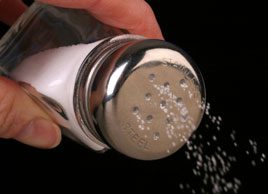Canada’s approach to cutting sodium
Will sodium reduction strategies work in Canada? Find out what Health Canada and the government are doing to improve our nutrition

Source: Best Health Magazine, March/April 2012
Canadian adults consume on average about 3,400 milligrams’one and a half teaspoons’of salt every day, about 50 percent more than the maximum recommended level. Salt is deeply embedded in the food system, with only small proportions added during cooking (6%) and at the table (5%).
In the summer of 2010, the federal government’s Sodium Working Group recommended a reduction strategy. Its lynchpin is the goal of reducing daily salt intake levels to 2,300 milligrams by 2016 through a ‘structured voluntary approach.’ It includes published sodium reduction targets for food, and third-party monitoring. It also includes this veiled threat: a plan for ‘independent evaluation of the success of the program with the option of taking strong measures as necessary depending on progress.’
In January 2011, Health Canada announced it would adopt the recommendations, with the goal of cutting average per capita sodium consumption within the next four years. It’s currently seeking industry feedback to ensure salt can be reduced in a wide range of ingredients and processed products.
But will it work? In the U.S., a wide-ranging study published in 2010 by the Institute of Medicine (IOM) concluded that four decades of voluntary sodium reduction policies and public awareness campaigns haven’t delivered. ‘Food industry efforts to voluntarily reduce the sodium content of the food supply face obstacles, are not consistently undertaken by all, are not readily sustained, and have proven unsuccessful in lowering overall sodium intake,’ state the study’s authors. The situation is ‘a significant failure’ due to the growing incidence of salt-related chronic illness. The IOM’s solution includes mandatory national standards for salt content.
The CRFA’s Garth Whyte agrees that Canada’s approach should be a national one. Yet the Sodium Working Group report suggests there’s no broad consensus among industry players about the use of mandatory targets, even for toddler foods.
Canadians seem to be far less ambivalent. Surveys done for the working group found ‘there is a preference among Canadians for a mandatory labelling system by a two to one margin, and a strong sense among Canadians that high-sodium foods should be required to display symbols or words acknowledging this.’
This article was originally titled "The on sodium" in the March/April 2012 issue of Best Health. Subscribe today to get the full Best Health experience’and never miss an issue!




